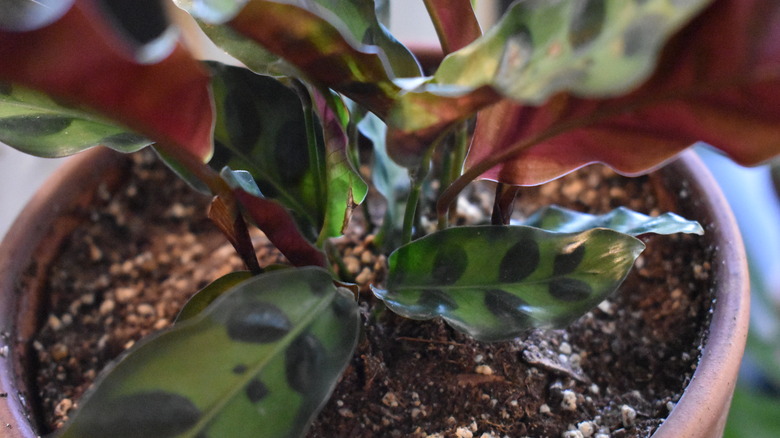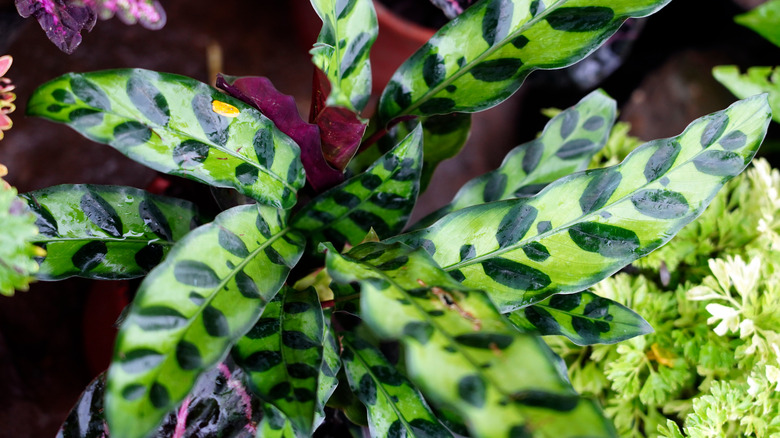Why Your Rattlesnake Plant Is Losing Leaves (And What To Do About It)
You've noticed that your rattlesnake plant is losing leaves, and you're understandably concerned since this tropical beauty is known for its vibrant foliage. Originating from the Brazilian rainforest, this captivating plant has striking leaf patterns resembling a rattlesnake's skin. Its tropical lineage means it's also sensitive to its surroundings. So, if you notice leaves dropping, it's a clear signal to dig deeper.
Your rattlesnake plant could be going through a couple of different scenarios. First, it's important to remember that shedding leaves isn't necessarily a sign of ill health. As plants grow, they do naturally lose some leaves. Second, if your plant is shedding leaves, it could be reacting to stress or shock due to a less-than-ideal temperature setting. Remember that this tropical gem loves warmth and humidity, making it essential to mimic those conditions for the plant to fully flourish. Its affinity for warm and humid climates requires just the right temperature range to truly thrive.
Stress and shock from cold weather
As mentioned, rattlesnake plants are tropical in nature, and they thrive best when their surroundings mimic their native habitat. So, if you're not maintaining an environment between 65 to 80 degrees Fahrenheit, don't be surprised if your lovely plant starts showing its displeasure by shedding leaves. Yes, these green beauties can be a bit temperamental, but don't worry — it's just their way of communicating. Moreover, watch out for those cold drafts. They're not just uncomfortable for you. They're a major stress factor for your plant, too, especially when the drafts come from air conditioning vents. Now, let's talk about air conditioning. It doesn't just cool down the air; it can also create dramatic fluctuations in both temperature and humidity levels, causing your plant even more stress.
Here's a pro tip that can be a game-changer: Position your rattlesnake plant at least three feet (approximately one meter) away from any AC vents. This simple adjustment helps maintain a stable temperature and humidity level, like creating a mini tropical paradise for your plant. In such an environment, if your plant could smile, it would.
To keep things in check, invest in a room thermometer. It's like giving your plant a wellness checkup. Regularly scan the environment to ensure the temperature is within that ideal range. If things aren't looking right, don't hesitate to relocate your plant to a more suitable spot. Your little jewel of the tropics will appreciate the effort and thank you by flourishing with fresh, healthy leaves in no time.
Normal leaf shedding as the plant matures
As your plant matures, it's perfectly normal for it to let go of a few bottom leaves as a part of its natural growth cycle. Consider it the plant's way of refreshing itself. It's an organic process that's absolutely captivating and shouldn't be a cause for concern. However, if you notice a sudden uptick in the number of falling leaves, you should perform a quick health check. Inspecting the roots for signs of rot is crucial. Root rot isn't just your garden-variety issue; it's a severe problem often triggered by excessive watering, and it demands immediate attention. The golden rule here? Aim for soil that's consistently damp but not waterlogged. Finding that sweet spot between keeping the soil moist and well-drained can help you steer clear of the dreaded overwatering and its partner in crime, root rot.
Regarding light, the rattlesnake plant has specific needs that must be met for optimal health. Insufficient light or an imbalance can significantly affect its well-being, leading to excessive leaf drop. Therefore, placing it in a spot with indirect, filtered light and maintaining an ambient temperature within its comfort zone is advisable.
A well-fed rattlesnake plant is happy, so don't forget to fertilize. Aim for an even-mix fertilizer and administer it throughout the plant's active growing season, preferably every two weeks or at least once a month. All in all, understanding these nuances is essential for maintaining the health and vitality of your rattlesnake plant.


